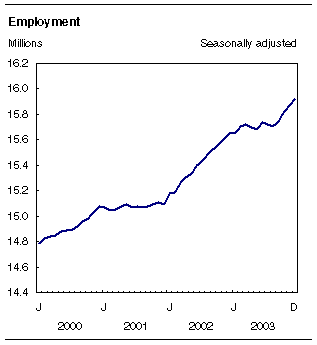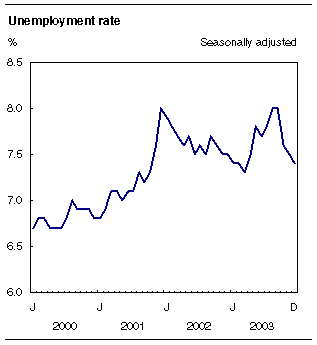
















 |
|
 |                |
Information identified as archived is provided for reference, research or recordkeeping purposes. It is not subject to the Government of Canada Web Standards and has not been altered or updated since it was archived. Please "contact us" to request a format other than those available.

|

Friday, January 9, 2004 Labour Force SurveyDecember 2003In December, employment increased by an estimated 53,000, mostly in full-time. Job gains over the past four months total 219,000 (+1.4%), four times the increase of 52,000 (+0.3%) observed during the first eight months of the year. Almost all of the job gains in 2003 were in full-time work. In December, the unemployment rate edged down 0.1 percentage points to 7.4%. 
The proportion of the working-age population holding a job (employment rate), rose to an all-time high of 62.7% in December. Similarly, the labour force participation rate reached a record level, rising to 67.7%. Manufacturing weakness slows overall job growth in 2003Over 2003, employment grew by only 1.7% (+271,000), down from the 3.7% (+560,000) growth rate observed in 2002. The slowdown in employment growth in 2003 is attributable to job losses in the manufacturing sector. Since November 2002, the number of manufacturing jobs has declined by 82,000 (-3.5%). Almost all of the decline in manufacturing occurred in Quebec and Ontario. The industries hardest hit were computer and electronic products and electrical equipment and appliance manufacturing.
Employment gains for adult womenFor a fourth straight month, the number of jobs increased for both adult women and adult men. In December, employment increased by 33,000 among adult women, bringing gains over the year to 145,000 (+2.4%). Their unemployment rate fell 0.2 percentage points in December to 6.0%. The employment rate (57.5%) and the participation rate (61.2%) of adult women both reached record levels in December. 
In December, employment among adult men grew by 20,000. Their unemployment rate fell 0.4 percentage points to 6.1%, the result of a large decrease in the number of adult men looking for work. With gains at the beginning and at the end of the year, employment among adult men increased by 112,000 (+1.6%) over 2003. In contrast to the year before, labour market conditions remained weak for youths throughout 2003. Youth employment was little changed in December and finished the year up only 0.6%, well below the growth rate of 4.6% in 2002. As more youths were looking for work, their unemployment rate jumped 0.7 percentage points in December to 14.0%. Upward trend continues in health care and social assistance and in constructionIn December, employment rose in health care and social assistance (+28,000), management of companies and administrative and other support services (+25,000), transportation and warehousing (+13,000) and agriculture (+8,000). During 2003, four sectors were the main engines of employment growth. Health care and social assistance posted the largest increase, adding 77,000 jobs (+4.7%) since the start of the year. Employment in this sector has been rising since the summer of 2001. Over the past two years, low interest rates and a robust housing market continued to fuel strong employment growth in construction. Despite little change in December, the number of construction jobs is up 45,000 (+5.0%) over the year. The finance, insurance, real estate and leasing sector also gained from the real estate boom, adding 53,000 jobs (+5.9%) since the start of 2003. After little change in 2002, employment in public administration grew in the first eight months of 2003. This sector now has 47,000 more jobs (+6.0%) than a year ago. Following strong growth in 2002, employment in the professional, scientific and technical services sector remained flat for much of 2003. The sector ended the year on a negative note, with a decrease of 15,000 jobs in December. This decline brings losses for the year to 36,000 (-3.5%), mainly in computer systems design and legal services. Job gains continue in both private and public sectorsIn December, the private sector increased by 40,000 employees, bringing gains since the start of the year to 106,000 (+1.0%). The public sector added 18,000 employees in December, bringing year-over-year gains to 107,000 (+3.6%). As a result of strength of the construction sector, the number of self-employed workers grew by 58,000 (+2.5%) in 2003, with most of the increase in the first eight months of the year. Employment grows in a number of provincesSeven provinces posted employment gains in December, with the largest increase in Ontario. After two months of little change, Ontario added 35,000 jobs in December, nearly two-thirds of them full-time. The bulk of the increase was in management of companies and administrative and other support services and in accommodation and food services. The province's unemployment rate edged down 0.1 percentage points to 6.7%. Following strong growth in the second half of 2002, employment in Ontario continued to grow in the first quarter of 2003, but paused from April to August. In recent months, employment in the province has rebounded, ending the year up 120,000 (+1.9%). Major job losses in manufacturing and in professional, scientific and technical services slowed employment growth in 2003. However, other industries more than offset these decreases. The largest job gains in 2003 occurred in health care and social assistance and in management of companies and administrative and other support services. In December, employment increased by 24,000 in British Columbia, all in full-time. The increases in recent months account for more than two-thirds of the 77,000 job gains observed since the start of 2003. Job growth in December was spread over several industries, including health care and social assistance, construction, and management, administrative and other support services. The unemployment rate fell 0.8 percentage points to 6.8%, a rate not seen since May 2001. After a slow start, employment in Alberta resumed its upward trend and ended 2003 on a positive note, with an increase of 11,000 jobs in December. This leaves the province with 44,000 more jobs (+2.6%) since the start of the year. In December, the largest employment gains occurred in health care and social assistance and in agriculture. The unemployment rate edged down 0.1 percentage points to 4.9%. In December, the proportion of Alberta's working-age population holding a job reached 70.2%, the first time the employment rate has exceeded 70%. Nova Scotia added 4,000 jobs in December, bringing growth since the start of the year to 7,000 (+1.7%). This is slightly higher than the gain registered in 2002. December's gains were spread across a number of industries, with the largest occurring in retail and wholesale trade, health care and social assistance, and construction. The December unemployment rate fell 1.1 percentage points to 9.0%. Driven by an increase in full-time work, employment rose by 3,000 in Manitoba in December. Growth was concentrated in transportation and warehousing and in manufacturing. The unemployment rate fell 0.4 percentage points to 5.0%. Despite job growth in the last quarter, the employment level was little changed (-0.3%) from a year ago. Following strong growth in 2002, employment in Saskatchewan declined slightly during the first nine months of 2003, before regaining some strength in the last quarter of the year. In December, 3,000 jobs were added, all of them full-time. Despite this increase, employment is down slightly (-0.7%) from a year ago. The unemployment rate remained unchanged in December at 5.7%, the result of an increase in labour force participation. In December, the number of jobs in Prince Edward Island edged up by an estimated 800, with a drop in part-time work partly offsetting a rise in full-time employment. As a result, the unemployment rate fell 1.0 percentage points to 10.1%. Employment was little changed for most of 2003, with the exception of a sharp increase in June. Employment in the province finished the year up 2,300 (+3.4%). As a result of a large drop in manufacturing jobs, employment in Quebec fell by 27,000 in December, all in full-time. This decline partly offset the 80,000 job gains during the previous two months. December's unemployment rate was 9.4%, up 0.3 percentage points from November. Employment in the province changed little during the first nine months of the year, finishing the year up by only 0.7% (+27,000), a much lower growth rate than in 2002. Manufacturing losses were responsible for the weak growth in overall employment in 2003. Since its most recent peak in November 2002, this sector has lost 44,000 jobs. However, manufacturing declines were more than offset by employment gains in health care and social assistance, finance, insurance, real estate and leasing, and construction. Following two consecutive monthly declines, employment was little changed in Newfoundland and Labrador in December. A number of small increases during the year left the province with 2,000 more jobs (+1.0%) than at the end of 2002, with most of the increase in the natural resources and manufacturing sectors. After rising in November, employment was little changed in December in New Brunswick. Employment in the province fluctuated throughout the year, leaving the number of jobs 4,000 lower (-1.1%) than a year ago. This situation contrasts with strong job growth in 2002. Available on CANSIM: tables 282-0001 to 282-0042 and 282-0047 to 282-0095. Definitions, data sources and methods: survey number 3701. Available at 7:00 a.m. on our website. From the home page, choose Today's news releases from The Daily, then Latest Labour Force Survey. A more detailed summary, Labour force information, is available today for the week ending December 13 (71-001-XIE, $9/$84). Data tables are also available in the Canadian statistics module of our website. The next release of the Labour Force Survey will be on Friday, February 6. For general information or to order data, contact Client Services (1-866-873-8788; 613-951-4090; labour@statcan.gc.ca). To enquire about the concepts, methods or data quality of this release, contact Vincent Ferrao (613-951-4750) or Stéphanie Langlois (613-951-3180), Labour Statistics Division.
| ||||||||||||||||||||||||||||||||||||||||||||||||||||||||||||||||||||||||||||||||||||||||||||||||||||||||||||||||||||||||||||||||||||||||||||||||||||||||||||||||||||||||||||||||||||||||||||||||||||||||||||||||||||||||||||||||||||||||||||||||||||||||||||||||||||||||||||||||||||||||||||||||||||||||||||||||||||||||||||||||||||||||||||||||||||||||||||||||||||||||||||||||||||||||||||||||||||||||||||||||||||||||||||||||||||||||||||||||||||||||||||||||||||||||||||||||||||||||||||||||||||||||||||||||||||||||||||||||||||||||||||||||||||||||||||||||||||||||||||||||||||||||||||||||||||||||||||||||||||||||||||||||||||||||||||||||||||||||||||||||||||||||||||||||||||||||||||||||||||||||||||||||||||||||||||||||||||||||||||||||||||||||||||||||||||||||||||||||||||||||||||||||||||||||||||||||||||||||||||||||||||||||||||||||||||||||||||||||||||||||||||||||||||||||||||||||||||||||||||||||||||||||||||||||||||||||||||||||||||||||||||||||||||||||||||||||||||||||||||||||||
|
|
|